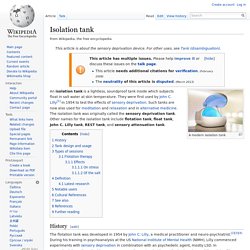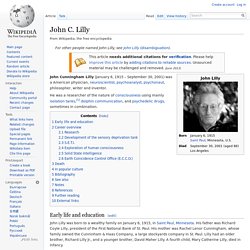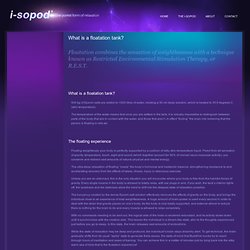

Isolation tank. An isolation tank is a lightless, soundproof tank inside which subjects float in salt water at skin temperature.

They were first used by John C. Lilly[1] in 1954 to test the effects of sensory deprivation. Such tanks are now also used for meditation and relaxation and in alternative medicine. The isolation tank was originally called the sensory deprivation tank. Other names for the isolation tank include flotation tank, float tank, John C. History[edit] The flotation tank was developed in 1954 by John C. Peter Suedfeld and Roderick Borrie of the University of British Columbia began experimenting on the therapeutic benefits of flotation tank usage in the late 1970s.
Tank design and usage[edit] In current tanks, a solution of epsom salt is used to increase water density. Generally, users of isolation tanks enter the pool nude. Cut through a float tank. Isolation tank construction and plumbing is typically all plastic. It is useful to have a shower stall in the same room as the tank. Hypnagogia. "Waking dream" redirects here.

It is not to be confused with daydreaming. Hypnagogia is the experience of the transitional state from wakefulness to sleep: the hypnagogic state of consciousness, during the onset of sleep. In opposition, hypnopompia denotes the onset of wakefulness. The related words from the Greek are agōgos "leading", "inducing", pompe "act of sending", and hypnos "sleep". Mental phenomena that occur during this "threshold consciousness" phase include lucid dreaming, hallucinations, and sleep paralysis. Definitions and synonyms[edit] Other terms for hypnagogia, in one or both senses, that have been proposed include "presomnal" or "anthypnic sensations", "visions of half-sleep", "oneirogogic images" and "phantasmata",[2] "the borderland of sleep", "praedormitium",[3] "borderland state", "half-dream state", "pre-dream condition",[4] "sleep onset dreams",[5] "dreamlets",[6] and "wakefulness-sleep transition" (WST).[7] History[edit] Sensory phenomena[edit]
John C. Lilly. John Cunningham Lilly (January 6, 1915 – September 30, 2001) was a American physician, neuroscientist, psychoanalyst, psychonaut, philosopher, writer and inventor.

He was a researcher of the nature of consciousness using mainly isolation tanks,[1] dolphin communication, and psychedelic drugs, sometimes in combination. Early life and education[edit] John Lilly was born to a wealthy family on January 6, 1915, in Saint Paul, Minnesota. His father was Richard Coyle Lilly, president of the First National Bank of St. Paul. Lilly showed an interest in science at an early age.
While at St. Despite his father's wishes for him to go to an eastern Ivy-league college to become a banker, Lilly accepted a scholarship at the California Institute of Technology to study science. In 1934, Lilly read Aldous Huxley's Brave New World. Lilly became engaged to his first wife, Mary Crouch, at the beginning of his junior year at Caltech. At the University of Pennsylvania, Lilly met a professor named H. What is a floatation tank? - Float Tank » Floatation Tank » Isolation Tanks » Sensory Deprivation Tank. What is a floatation tank?

500 kg of Epsom salts are added to 1000 litres of water, creating a 30 cm deep solution, which is heated to 35.5 degrees C (skin temperature). The temperature of the water means that once you are settled in the tank, it is virtually impossible to distinguish between parts of the body that are in contact with the water, and those that aren’t, in effect “fooling” the brain into believing that the person is floating in mid-air. The floating experience Floating weightlessly your body is perfectly supported by a cushion of silky skin-temperature liquid. Freed from all sensation of gravity, temperature, touch, sight and sound (which together account for 90% of normal neuro-muscular activity), you conserve and redirect vast amounts of natural physical and mental energy. Unless you are an astronaut, this is the only situation you will encounter where your body is free from the harmful forces of gravity. The History of the Floatation tank Together with his associate Dr.